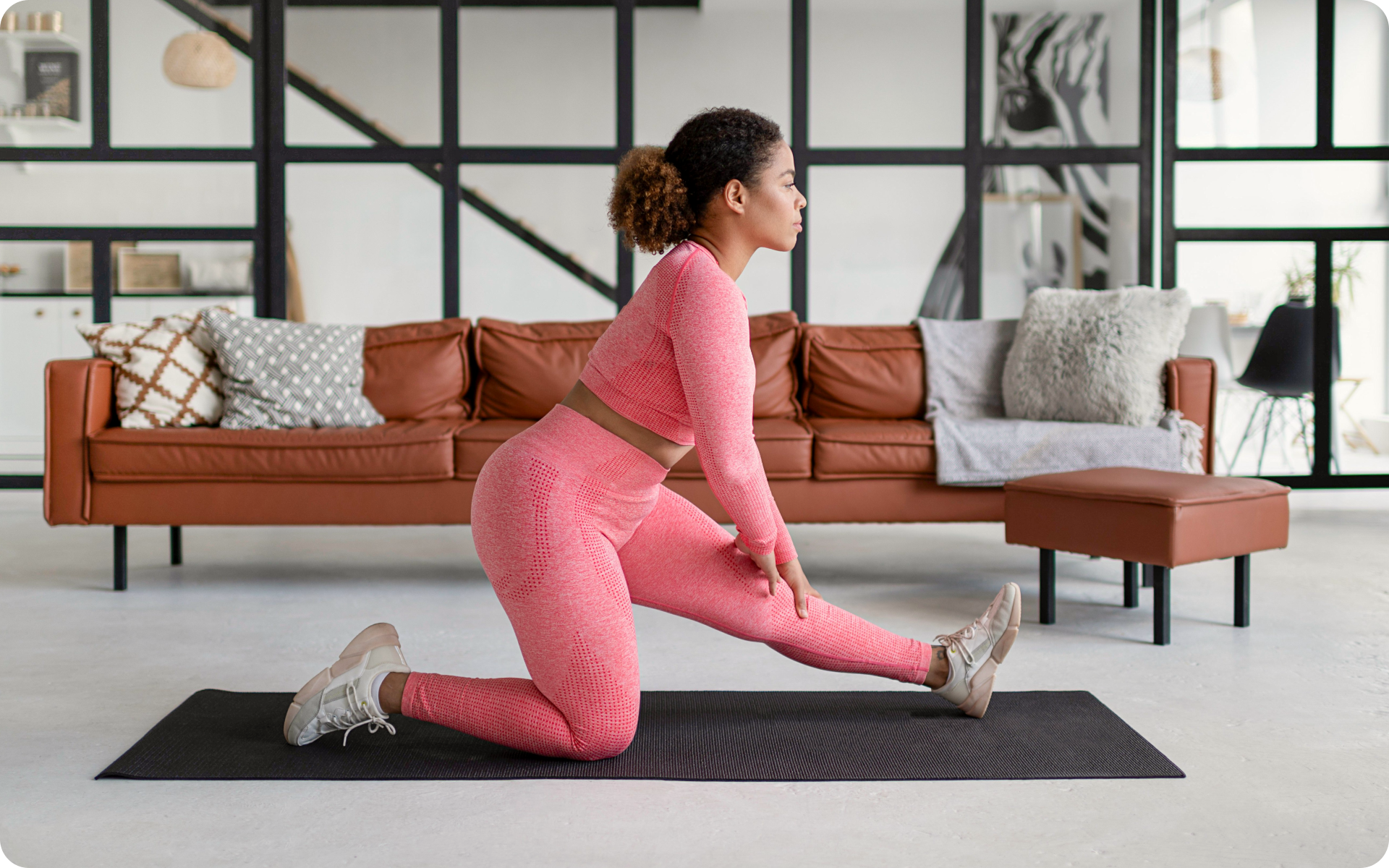Having a high body fat percentage is associated with numerous health risks, including heart disease, diabetes, and even some forms of cancer. That’s because excessive fat, especially around the abdomen, can significantly harm your body’s ability to function optimally.
Most weight loss strategies highlight short-term success, offering solutions that are temporary at best, and fail to address the fundamental principles of sustainable body fat reduction.
Losing weight and keeping it off requires a comprehensive overhaul of your lifestyle, integrating disciplined eating habits, consistent physical activity, and an understanding of your body’s unique needs (18).
Here is what you need to know to reduce your body fat percentage for good.
Why Do We Calculate Body Fat Percentage?
Body fat percentage is a more accurate measure of your health and fitness level than a scale alone. It represents the percentage of your total body weight that is made of fat tissue.
Body fat percentage takes into consideration both essential and non-essential fats and gives a better indication of how much fat is stored in your body.
In comparison, your Body Mass Index (BMI) only takes into consideration your height and weight and does not differentiate between muscle mass and fat mass.
A person with a high BMI but a low body fat percentage may still be considered healthy, whereas someone with a normal BMI but a high body fat percentage could be at risk for various health issues.
The National Academy of Sports Medicine highlights three reasons why you shouldn’t rely on your BMI alone to assess your health (9):
- BMI does not differentiate between fat and muscle mass, which can lead to a misclassification of individuals as overweight or obese.
- BMI tends to underestimate body fat among taller people and overestimate it among shorter people.
- BMI doesn’t account for racial and ethnic differences in body composition (for example, people of Asian descent may have a higher body fat percentage, at the same BMI as those of Caucasian descent).
Unfortunately, many individuals don’t realize the importance of body fat percentage and only focus on losing weight, which can lead to a loss of muscle mass as well.
This is why it’s essential to understand how to reduce your body fat percentage, instead of just aiming for a lower number on the scale.
Betterme will keep you laser-focused on your weight loss journey! Nutrient-packed meal plans, fat-blasting workouts, galvanizing challenges and much more. Try using the app and see for yourself!
What Is a Healthy Body Fat Percentage?
According to the American Council on Exercise, a healthy body fat percentage varies because of factors such as age and gender (6). Women need a higher percentage of body fat than men, due to hormonal and reproductive differences.
The Council categorizes body fat into ranges, as seen below:
- Essential fat: 10-13% for women and 2-5% for men. This is the minimum amount of body fat needed for survival, essential bodily functions, and reproductive health.
- Athletes: 14-20% for women and 6-13% for men. Most athletes fall into this category, as they have more muscle mass and lower levels of body fat.
- Fitness: 21-24% for women and 14-17% for men. Individuals in this range are considered to be fit and healthy.
- Average/acceptable: 25-31% for women and 18-24% for men. This range is considered acceptable, but individuals may be at risk for health issues.
- Obese: More than 32% for women and more than 25% for men. Individuals in this category have an increased risk of developing chronic diseases such as diabetes, heart disease, and cancer.
With these figures in mind, your goal should be to aim for a healthy body fat percentage, rather than just losing weight or reaching a specific number on the scale.
There are many ways to calculate body fat percentage, but the most accurate one according to NASM is by an autopsy (15). Obviously, this is not practical, so we rely on other methods such as:
- Calipers: This method involves using a tool to measure skinfold thickness at various points on the body. It’s relatively inexpensive and can be done by a trainer or health professional.
- Hydrostatic weighing: This method involves submerging your body in water and measuring the displacement to determine body density. It’s a highly accurate method but can be expensive and time-consuming.
- Bioelectrical Impedance Analysis (BIA): This non-invasive method measures the amount of resistance to an electrical current as it travels through your body. While it is relatively easy and inexpensive, its accuracy may vary depending on factors such as hydration levels.
- Dual-Energy X-Ray Absorptiometry (DEXA): This method uses two low-dose x-rays to measure body composition, including bone density, muscle mass, and fat percentage. It’s considered the gold standard for measuring body fat percentage but is also expensive.
- Body Circumference: This method involves measuring the circumference of various body parts such as the waist, hips, and thighs. While it may not be as accurate as other methods, it can give you a general idea of your body fat percentage.
Ultimately, no matter which method you use to calculate your body fat percentage, what matters is that you are consistently working towards maintaining a healthy level.
How To Reduce Body Fat Fast?
Fast fat loss isn’t the goal when it comes to reducing body fat percentage. The Centers for Disease Control and Prevention recommends aiming to lose 1-2 pounds per week (14), which equates to a calorie deficit of 500-1000 calories per day. Sustainable and healthy habits are what will lead to long-term success.
Here are some tips to help you reduce your body fat percentage effectively:
Start With Bodyweight Exercise and Build Up To Lifting Weights
Strength training is more effective at reducing body fat than aerobic exercise alone; according to a 4-week study published by the International Journal of Obesity of 304 adolescents with obesity (8).
The study participants were split between high- and low-intensity aerobic exercise programs. The group that also added resistance training saw significant reductions in body fat percentage, compared to the group that only did aerobic exercise (8).
Resistance training is superior because it increases muscle mass, which in turn leads to a higher metabolism and more efficient fat burning. It preserves lean tissue, instead of just losing overall weight (11).
Bodyweight exercises such as push-ups, squats, and lunges can be a great starting point, as they can help build muscle mass, while also improving balance and coordination (17). As you get stronger, you can then progress to using weights or resistance bands for added intensity.
Read more: Different Types of Body Fat and What They Mean for Your Health
Incorporate HIIT Into Your Workout Routine
High-Intensity Interval Training (HIIT) involves short bursts of intense activity, followed by periods of rest or low-intensity exercise. It’s been shown to be more effective in reducing body fat compared to moderate-intensity continuous training (MICT) (7).
An advantage of HIIT is that it can be done in a shorter amount of time, making it easier to fit into your busy schedule. This also continues to burn calories even after the workout, known as the “afterburn effect.”
If you want to reduce body fat percentage at home, you can try incorporating HIIT exercises such as burpees, mountain climbers, or sprints into your routine.
You can also try dancing as cardio.We’ve discussed this further in our zumba calories burned article.
Don’t Neglect Nutrition
No matter how much you exercise, if your nutrition isn’t on point, you won’t see significant changes in body fat percentage.
Some points to note while eating to reduce your body fat percentage include:
- Calorie deficit: As mentioned earlier, creating a calorie deficit is essential for fat loss. This can be achieved by reducing your daily caloric intake or increasing physical activity (5).
- Protein intake: Consuming enough protein is crucial for maintaining and building muscle mass while reducing body fat. Aim for at least 0.7-1 gram of protein per pound of bodyweight (16).
- Healthy fats: Don’t be afraid to incorporate healthy fats into your diet; they are essential for hormone production and can help keep you feeling full. Good sources include avocados, nuts and seeds, olive oil, and fatty fish (16).
- Increase fiber intake: Fiber is important for keeping you full and will also help with digestion. Aim for at least 25 grams of fiber per day (16).
- Limit processed foods: These often contain added sugars and unhealthy fats that contribute to increased body fat percentage. Stick to whole, unprocessed foods as much as possible (16).
Consider Small, Sustainable Changes
While it may be tempting to jump into a restrictive diet and intense workout routine, this is often not sustainable in the long run. Instead, focus on making small changes that you can maintain over time.
Some examples include:
- Drinking more water: Staying hydrated can help with weight loss by increasing metabolism and reducing appetite (10).
- Getting enough sleep: Lack of sleep has been linked to weight gain, so aim for at least 7-9 hours of quality sleep each night (1).
- Managing stress levels: Stress often leads to overeating and poor food choices. Find healthy ways to manage stress, such as exercise, meditation, or talking to a therapist (12).
Recent research on Cognitive Behavioral Therapy for Obesity highlights the effectiveness of addressing psychological factors, such as stress and emotional eating, in promoting sustainable weight loss (4).
It also emphasizes the importance of setting realistic goals and recognizing that weight loss is a journey, not a quick fix. By incorporating these small changes into your daily routine, you can work towards reducing your body fat percentage sustainably.
Our, How to Lose Weight After 50, blog details ways the elderly population can also get on their own weight loss journey.
How Do I Lower My Body Fat Percentage with Fasting?
Intermittent Fasting (IF) can be effective in reducing body fat percentage by promoting fat burning and preserving muscle mass (13).
To lower your body fat percentage with fasting, follow these rules
- Choose an IF method: There are several methods of intermittent fasting, including the 16/8 method, where you fast for 16 hours and have an 8-hour eating window. Find one that works best for your schedule and lifestyle.
- Consume zero calories during fasting hours This includes no food or drinks except for water, black coffee, and plain tea. Consuming calories during fasting hours will break your fast.
- Be mindful of what you eat during eating windows: Consume nutrient-dense foods during your eating window. Fasting does not give you free rein to eat whatever you want during your eating window.
- Eat to satiety: Don’t restrict yourself too much during your eating window or you may end up overeating later on. Instead, listen to your body’s hunger and fullness cues and only eat until you are satisfied.
- Be consistent: To see results with IF, it’s important to be consistent with your fasting schedule. This means sticking to your chosen method and not giving in to temptations outside of the designated eating window.
BetterMe app will kick you out of the mental funk, shake off your extra weight, rid you off your energy-zapping habits, and help you sculpt the body of your dreams. Intrigued? Hurry up and change your life for the better!
How Long Does It Take To Lose 5% Body Fat?
The amount of time it requires to lose 5% body fat will be different based on the individual since at different weights the number of pounds required to lose 5% is different. You’ll need to create a calorie deficit of 3,500 calories per week to lose 1 pound of fat.
The speed not only depends on your starting weight, but also on factors like your activity level. The more body fat you have to lose, the quicker the initial weight loss may be. Once you get closer to your goal and have less body fat to lose, the progress may slow down.
Usually, being consistent with your exercise and nutrition plan can guarantee a steady and healthy decrease in body fat percentage over time.
No matter what extreme method you choose, you can’t reduce body fat percentage in a week. Initial weight loss may occur due to water weight, but sustainable fat loss takes time and consistency.
Neither is a goal to lose 5 percent body fat in 2 weeks attainable. It all takes time.
What Are The Benefits of Lowering Body Fat Percentage?
Lowering body fat percentage improves both physical and mental health.
Some potential benefits include:
- Reduced risk of chronic diseases: Excess body fat, especially around the waist, has been linked to an increased risk of conditions such as type 2 diabetes, heart disease, and certain cancers (3).
- Improved athletic performance: With a lower body fat percentage comes improved endurance, strength, and power, making physical activities easier and more enjoyable (2).
- Better mental well-being: Excess body fat can negatively impact self-esteem and body image. By reducing body fat percentage, individuals may experience improved self-confidence and a positive outlook on their bodies (3).
- Increased longevity: Lowering body fat percentage can improve overall health and potentially increase lifespan by reducing the risk of chronic diseases (3).
Read more: 6 Body Fat: Why You Don’t Need Single Digit Body Fat Percentage to Look Good
FAQs
Is 25 Percent Body Fat Good?
25 percent body fat falls within the “normal” range for women and is considered acceptable. However, it’s considered in the “overweight” range for men, and they may want to aim for a lower body fat percentage.
How Fast Can You Lose 10% Body Fat?
You may be able to lose 10% body fat in 12-24 weeks with a calorie deficit and consistent exercise routine. However, the time frame may vary depending on individual factors.
A safe and sustainable rate of weight loss is considered to be 1-2 pounds per week (14)
Note; the time it takes to go from 20% body fat to 10% can be twice as long as it took to go from 30% to 20%. This indicates that as your body fat percentage decreases, the rate of fat loss can slow down, making it harder to lose additional fat.
Can You Lose 10% Body Fat In 6 Weeks?
Losing 10% body fat in 6 weeks is possible, but it would require a significant calorie deficit and intense exercise regimen. This may not be sustainable or healthy long-term. It’s important to prioritize slow and steady weight loss for lasting results. A reasonable timeline for losing 10% body fat would be around 12-24 weeks.
The Bottom Line
Lowering body fat percentage is important for both physical and mental health. By incorporating small, sustainable changes into your daily routine such as a healthy diet, regular exercise, and managing stress levels, you can work towards reducing your body fat percentage over time. Combining these lifestyle changes with methods like intermittent fasting can also be effective in promoting fat loss.
DISCLAIMER:
This article is intended for general informational purposes only and does not serve to address individual circumstances. It is not a substitute for professional advice or help and should not be relied on for making any kind of decision-making. Any action taken as a direct or indirect result of the information in this article is entirely at your own risk and is your sole responsibility.
BetterMe, its content staff, and its medical advisors accept no responsibility for inaccuracies, errors, misstatements, inconsistencies, or omissions and specifically disclaim any liability, loss or risk, personal, professional or otherwise, which may be incurred as a consequence, directly or indirectly, of the use and/or application of any content.
You should always seek the advice of your physician or other qualified health provider with any questions you may have regarding a medical condition or your specific situation. Never disregard professional medical advice or delay seeking it because of BetterMe content. If you suspect or think you may have a medical emergency, call your doctor.
SOURCES:
- Adequate sleep to improve the treatment of obesity (2012,nih.gov)
- Association between Variation in Body Fat Mass Magnitude and Intake of Nutrients, including Carbohydrates, Fat, and B Vitamins, in a Cohort of Highly Trained Female Athletes (2023,nih.gov)
- Aim for a Healthy Weight (2023,health.gov)
- An Update on Mental Health Problems and Cognitive Behavioral Therapy in Pediatric Obesity (2020,nih.gov)
- Calorie Deficit: What To Know (2022,clevelandclinic.org)
- Demystifying Body Fat Percentages: A Healthy Range Explained (2023,ace.org)
- Effectiveness of high-intensity interval training for weight loss in adults with obesity: a randomised controlled non-inferiority trial (2021,nih.gov)
- Evidence for Resistance Training as a Treatment Therapy in Obesity (2011,nih.gov)
- FIT VERSUS FAT – WHICH RULES YOUR HEALTH? (2022,nasm.org)
- Increased Hydration Can Be Associated with Weight Loss (2016,nih.gov)
- Increasing muscle mass to improve metabolism (2013,nih.gov)
- Impact of a stress management program on weight loss, mental health and lifestyle in adults with obesity: a randomized controlled trial (2018,nih.gov)
- Intermittent fasting and weight loss (2020,nih.gov)
- Losing Weight (2023,cdc.gov)
- NASM’s Body Fat Calculator (2014,nasm.org)
- Optimal Diet Strategies for Weight Loss and Weight Loss Maintenance (2021,nih.gov)
- The advantages of body-weight exercise (2022,harvard.edu)
- Weight-Loss and Maintenance Strategies (2003,nih.gov)










